Intel P965: The Double Mint Twins Gone Wild
by Gary Key on November 9, 2006 8:00 PM EST- Posted in
- Motherboards
Gigabyte GA-965P-S3: Board Layout and Features
Gigabyte has engineered a nice board with a very good layout that unfortunately keeps the same color combination (or lack thereof) from the DS3. The board installed into our case without problems and all connections were easily reached. The board features a three-phase voltage regulator system that provided excellent stability throughout our testing. Unlike the DS series that use 100% Conductive Polymer Aluminum Solid Capacitors our S3 board uses a combination of solid and electrolytic capacitors. The purpose of the Conductive Polymer Aluminum Solid capacitors is theoretically to improve system durability and to provide for added stability under heavy load operations such as overclocking. However, we did not notice any differences in our testing, but the long term benefits of the solid capacitors could be significant in terms of the board's lifespan.

The DIMM module slots' color coordination is once again correct for dual channel setup based upon the premise of installing DIMMs in the same colored slots for dual-channel operation. The memory modules are slightly difficult to install with a full size video card placed in the PCI Express x16 slot. The 24-pin ATX power connector and black floppy drive connector are located along the edge of the board and behind the DIMM slots. The board only comes with two fan headers with the CPU fan header being located to the right of the first DIMM slot. We usually prefer a minimum of four fan headers on a motherboard.
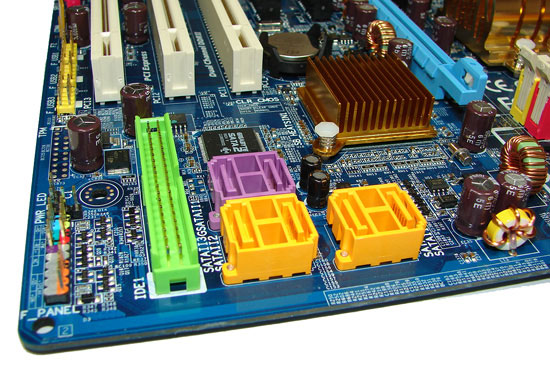
The four Intel ICH8 SATA ports are color coded yellow and the two JMicron JMB363 SATA ports are in a wonderful shade of lavender next to the green IDE connector. We found the positioning of the SATA ports to be excellent when utilizing the PCI 2.3 slots although we still prefer the IDE connector on the edge of the board to facilitate better cable management. The ICH8 is passively cooled with a gold colored low-rise heatsink and remained fairly cool to the touch throughout testing.
The chassis panel is located at the bottom left corner of the board. The clear CMOS jumper is located in between the battery and ICH8 chipset. This is a two pin configuration and requires the use of a pen to reach and is blocked if a card is installed in the first PCI slot. It seems to be a trend lately of the various manufacturers to place this jumper in the most inconvenient locations. Until the BIOS recovery programs work 100% of the time it would be nice to have this jumper out in the open, or even better go with the "button" design that we've seen used by a few manufacturers.
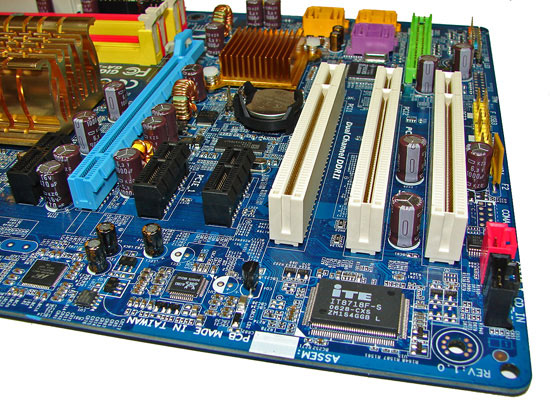
The board comes with one physical PCI Express x16 connector, three PCI Express x1 connectors, and three PCI 2.3 connectors. The layout of this design offers a very good balance of expansion slots for a mainstream performance board while providing excellent clearance space for graphics card utilization. The second PCI Express x1 slot will be blocked by a dual slot graphics card but considering the dearth of PCI Express peripherals this is fully acceptable. The first PCI Express x1 slot is a tight fit as a card installed in this slot will have minimal clearance between the MCH heatsink and video card.
Returning to the CPU socket area, we find an ample amount of room for the majority of cooling solutions. We utilized the stock heatsink/fan in our base testing but also verified several of the larger Socket-775 cooling solutions would fit in this area during our overclocking tests. The 4-pin ATX power connector is placed on the far right side of the board and did not interfere with our various cooling units.
The Intel P965 MCH chipset is passively cooled with a mid-rise heatsink unit that did not interfere with any installed peripherals. Unfortunately, this heatsink is not very good at keeping the MCH cool during heavy overclocking. Gigabyte has used this design for the past year but has generally shipped a small fan that attaches to it for additional cooling. This heatsink needs it when running the system above 400FSB. However, even if it were included this board only has two fan headers which is not representative of a performance oriented board.
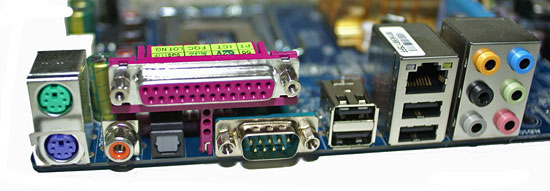
The rear panel contains the standard PS/2 mouse and keyboard ports along with serial and parallel ports for those who still require legacy peripherals. The panel also includes a LAN port, 4 USB ports, and two S/PDIF (optical out/coaxial out) ports. The LAN (RJ-45) port has two LED indicators representing Activity and Speed of the connection through the Marvell 88E8056 Gigabit PCI-E chipset. The audio panel consists of 6 ports that can be configured for 2, 4, 6, and 8-channel audio connections for the Realtek ALC 883 HD codec. The only item missing from our wish list would be a Firewire port if the board supported it.
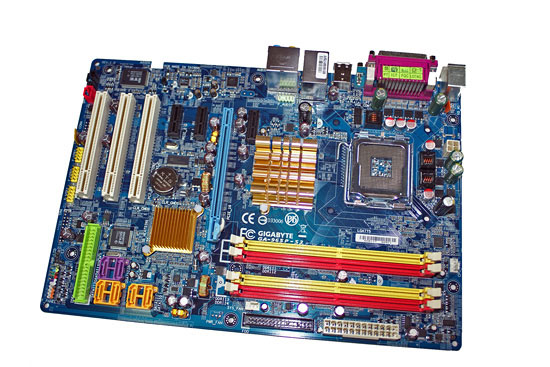 |
| Click to enlarge |
Gigabyte has engineered a nice board with a very good layout that unfortunately keeps the same color combination (or lack thereof) from the DS3. The board installed into our case without problems and all connections were easily reached. The board features a three-phase voltage regulator system that provided excellent stability throughout our testing. Unlike the DS series that use 100% Conductive Polymer Aluminum Solid Capacitors our S3 board uses a combination of solid and electrolytic capacitors. The purpose of the Conductive Polymer Aluminum Solid capacitors is theoretically to improve system durability and to provide for added stability under heavy load operations such as overclocking. However, we did not notice any differences in our testing, but the long term benefits of the solid capacitors could be significant in terms of the board's lifespan.

The DIMM module slots' color coordination is once again correct for dual channel setup based upon the premise of installing DIMMs in the same colored slots for dual-channel operation. The memory modules are slightly difficult to install with a full size video card placed in the PCI Express x16 slot. The 24-pin ATX power connector and black floppy drive connector are located along the edge of the board and behind the DIMM slots. The board only comes with two fan headers with the CPU fan header being located to the right of the first DIMM slot. We usually prefer a minimum of four fan headers on a motherboard.

The four Intel ICH8 SATA ports are color coded yellow and the two JMicron JMB363 SATA ports are in a wonderful shade of lavender next to the green IDE connector. We found the positioning of the SATA ports to be excellent when utilizing the PCI 2.3 slots although we still prefer the IDE connector on the edge of the board to facilitate better cable management. The ICH8 is passively cooled with a gold colored low-rise heatsink and remained fairly cool to the touch throughout testing.
The chassis panel is located at the bottom left corner of the board. The clear CMOS jumper is located in between the battery and ICH8 chipset. This is a two pin configuration and requires the use of a pen to reach and is blocked if a card is installed in the first PCI slot. It seems to be a trend lately of the various manufacturers to place this jumper in the most inconvenient locations. Until the BIOS recovery programs work 100% of the time it would be nice to have this jumper out in the open, or even better go with the "button" design that we've seen used by a few manufacturers.

The board comes with one physical PCI Express x16 connector, three PCI Express x1 connectors, and three PCI 2.3 connectors. The layout of this design offers a very good balance of expansion slots for a mainstream performance board while providing excellent clearance space for graphics card utilization. The second PCI Express x1 slot will be blocked by a dual slot graphics card but considering the dearth of PCI Express peripherals this is fully acceptable. The first PCI Express x1 slot is a tight fit as a card installed in this slot will have minimal clearance between the MCH heatsink and video card.
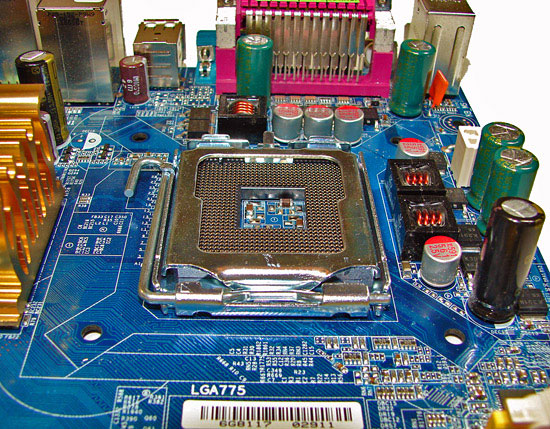 |
| Click to enlarge |
Returning to the CPU socket area, we find an ample amount of room for the majority of cooling solutions. We utilized the stock heatsink/fan in our base testing but also verified several of the larger Socket-775 cooling solutions would fit in this area during our overclocking tests. The 4-pin ATX power connector is placed on the far right side of the board and did not interfere with our various cooling units.
The Intel P965 MCH chipset is passively cooled with a mid-rise heatsink unit that did not interfere with any installed peripherals. Unfortunately, this heatsink is not very good at keeping the MCH cool during heavy overclocking. Gigabyte has used this design for the past year but has generally shipped a small fan that attaches to it for additional cooling. This heatsink needs it when running the system above 400FSB. However, even if it were included this board only has two fan headers which is not representative of a performance oriented board.

The rear panel contains the standard PS/2 mouse and keyboard ports along with serial and parallel ports for those who still require legacy peripherals. The panel also includes a LAN port, 4 USB ports, and two S/PDIF (optical out/coaxial out) ports. The LAN (RJ-45) port has two LED indicators representing Activity and Speed of the connection through the Marvell 88E8056 Gigabit PCI-E chipset. The audio panel consists of 6 ports that can be configured for 2, 4, 6, and 8-channel audio connections for the Realtek ALC 883 HD codec. The only item missing from our wish list would be a Firewire port if the board supported it.










23 Comments
View All Comments
Zak - Tuesday, November 14, 2006 - link
Yeah, WTF with the software design? Did they hire someone fired from FisherPrice or what? It's ugly and dysfunctional, even Asus AI Booster isn't THIS ugly.<Z>
mindless1 - Monday, November 13, 2006 - link
Regarding the article comment about the floppy connector,"We would just as well have this connector disappear at this time."
you might want to clarify who "we" is, since there are plenty of people who want a floppy connector even if they don't have a constant use for a floppy drive.
Remember that one person's use of a system does not equal entire world. Many legacy apps and even some emergency bios recovery routines require a floppy drive. If this were a reduced form factor board, it stands to reason that more features requiring connectors need to be left out, but to give up functionality on a whim is hardly useful, it's not as though you would have to grand replacement feature on that bottom edge, cubic inch of space otherwise.
Larso - Friday, November 10, 2006 - link
Oh my, do those motherboard monitoring/tuning applications look ugly... Ugly as in grotesque swollen blobs rather than functional design.A shame, I really liked the biostar board until the accompanying software utility appeared before for my eyes, aww... The gigabyte software is not pretty either... Can you switch the GUI to something less graphical and more standard windows widgets -like?
Do all software accompanying motherboards look like this??
Avalon - Saturday, November 11, 2006 - link
You mean you actually use software to overclock? Do it the manly way and use the BIOS.Larso - Saturday, November 11, 2006 - link
Its not about overclocking, the problem is if the motherboard software has some specific monitoring/adjusting features not available in freeware monitoring applications. Then you would have to use that monstrous software if you want the feature.Another problem is quality impression of the product as a whole. That software's user interface simply turns me off. Why don't they make the interface look like PRO tools, instead of plastic hell!
bullfrawg - Friday, November 10, 2006 - link
I think it's great that, as mentioned in the first article, you are checking out the manufacturer's tech support by pretending to be regular joes rather than review sites. So I want to express interest in seeing more detail about how tech support treats you. ASUS seems to have gotten a bad reputation lately for tech support -- is this justified in your experience? I see that you say Gigabyte has been good so far. Thanks!Staples - Friday, November 10, 2006 - link
The 965 performs very well no matter what board it is on. I will be waiting till you get a 650i Ultra board to review. I am holding out on a Core Duo and my next purchase will be between these two chipsets.Kensei - Friday, November 10, 2006 - link
Nice old school reference back to the double-mint twins. You definitely dated yourself with that one Gary.Kensei
Hikari - Friday, November 10, 2006 - link
Not really, I saw a double mint advertisement on TV with twins the other day...Kensei - Friday, November 10, 2006 - link
Really! I didn't know they had done a remake of that commercial.Ken